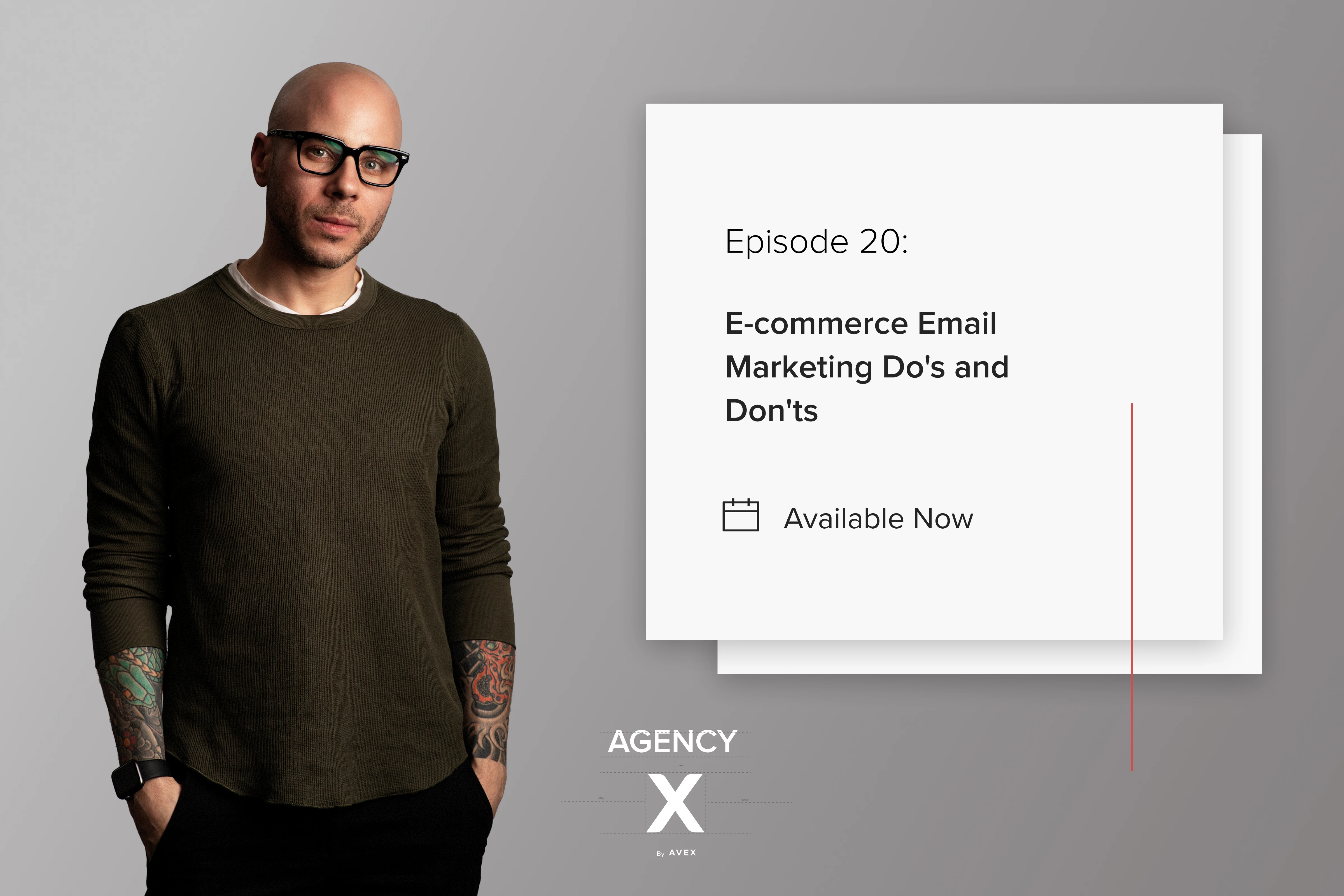Agency X Podcast: E-commerce Email Marketing Do's and Don'ts (w/Morgan Mulloy, our Email Marketing Manager)

Quick Summary How many emails should your brand send out every week? What are the best email practices for subscription-based brands? We answer these questions and more with the help of our guest, Morgan, who is Avex's very own email marketing manager.
We highlighted the best tips and insights from our conversation below broken down by topic, including Klaviyo tips, how often to run AB tests, and possible reasons for a high abandoned cart rate. Listen to the full episode below!
Branding/Design Of Email Content
David 03:13
In regards to email, when you're working with a variety of different brands, what would you say are some, like universal best practices overall? Regardless, if it's a dentist company, a clothing company, a CPG brand? What are those things that you look for, or kind of recommend off the bat?
Morgan 03:34
Yeah, definitely, things I see often and I think the email programs that I see out there that are just killing it are the ones that are really staying true to their brand. They're presenting their brand, no matter what the email topic is. So their design looks like their website looks like their social media, you know who you're getting this email from. And CTAs, I cannot reiterate enough how important these calls to action ends are in your email. The importance is just astronomical, keeping it above the fold. It's great to have lovely imagery, but we are a society that loves to push buttons literally and figuratively. So it's a great place to let them push buttons, get to your site, give them that action. Text is great, but for the most part, unfortunately, most people don't want to read a lot. So bite-size content with the opportunity to read more is always great. Shoppable shoppable shoppable. If your email is about a specific, say product and you have other products, find a way to incorporate those other products, so if your main focus doesn't appeal to that customer, they can find something else. And sometimes that's just footer categories or a data feed. It really helps keep that customer engaged.
Sending Frequency
John 05:07
I'm really interested in like frequency or the amount of campaigns that a brand might be pushing every week or every month or even every day, like we have some merchants that are maybe sending one to two. And then we have some, like one larger merchant who is sending one to two per day, where they're sending out, like 30 emails, and they're very profitable, they have a huge list. Is there any hard rule with how many emails a brand should send? Is it the bigger the brand, the more emails? Is it the type of product? What's some good indicators that let you decide on how many emails they should be pushing out every week or every month?
Morgan 05:59
Yeah, that's a great question. I think it's one that a lot of brands are saying, should I send every day, should I send once a month. I never recommend sending every day. You're going to fatigue your customer, they're going to know they're going to get an email, so there's no urgency to open it when they get it. Because they know tomorrow, there'll be another one.
John 06:19
Great point.
Morgan 06:20
I always say best practice sweet spot, I would say eight to 12, two to three a week, depending on your brand. And also if you are doing SMS, that can always backfill a little bit. So if you do eight campaigns a month via email, maybe SMS, you do three and that kind of brings you completely to 11 a month, that's a really good sweet spot. If you're going to send more than eight to 12, segmentation is key. You need to segment more than ever targeting whether based on gender, based on location, shopping habits, but I never recommend every day unless everything is super segmented. Yeah, I always find anywhere from eight to 12 to be a really nice sweet spot. And especially in the beginning, don't feel locked down to specific days of the week. I've worked with many clients that are like, well, we always send Tuesday and Saturday. And I'll say, Well, why? Well, that's just what we decided. But do you know if Monday is better? Do you know if there's a, like, test, figure it out, you're gonna pump more emails out during Black Friday, during the holidays. So you don't want to fatigue them throughout the year, when you're going to pretty much flood them during those really important times.
John 07:39
That's really valuable. That sounds good. And it makes a lot of sense. It also depends on as you said, the industry, the type of brand. But also, I think also the size of the catalog too. Some smaller DTC brands, maybe they have one product, of course, with one product you cannot send every day, especially its name tag product, like we've spoken about this brand a few times, Athletic Greens. They have one product, basically. They can't send emails every day, if they did, it would have to be like informative emails on how to use the product or lifestyle-type emails to get the most out of your nutrition or something like that. But if you're a clothing brand, and maybe you have a really large catalogue, men's and women's, I think you could get away with sending every day and on your point, as long as it's segmented.
Klaviyo Tip - Local Send Time
Morgan 09:43
So they do have some sendtime testing. There are a little bit of restrictions. You have a certain number on your list, but I believe it's about 10k? Don't quote me on that, I can definitely confirm. But it's worth testing those to get kind of a feel. Another thing I really like in Klaviyo, especially in terms of send time is you can do local send time. So say you want to do, everybody gets it at 8 am. 8 am on the west coast is different than 8 am on the east coast. So you can actually specify locals. So, in New Jersey, you're going to get it at 8 am and in California, you'll get it at your 8 am. In terms of the people opening it, they do have great reporting in terms of engagement, so you can look to see who was engaged in the list and who was not engaged in your list. And that can kind of help you narrow down their actions a little bit more. Other things you can do is really play with segmentation. You don't necessarily have to use the segments to send, you can provide the reports that you're looking for. If everybody on the East Coast, I want to know how many have purchased two or more times you can use that information. Otherwise, AB testing is great, you can do multiple versions, I think their max is 10, and test different send times. I want this one to go at 8 am and 8 pm, which one's going to get the most engagement. I personally recommend a full 50/50 test, so you can get a really clear answer. However, there are some hesitations with that. So Klaviyo also has the option where you can say, send 20%, and then the results after those 20%, the rest 80% of that list will get the winner. That's also possible, I always recommend, the more the better in the beginning to get really strong results.
AB Testing Best Practices
David 11:54
On that note, so something that does end up happening with AB testing, and really every realm is that, especially in the beginning, you'll run tests, and oftentimes you'll get results, you get a winner, but the margin of the winning variant is so slim, you can't really rely too heavily on it. What would you say is from, from the email side, in terms of either the number of tests or like percentage win by from like a specific variant that you have to kind of do before you can confidently say, Yeah, like, this is definitely the winning variant. This is this type of email versus this other kind, performs better, what's kind of the best practice from that from your side?
Morgan 12:42
Every test needs to happen a minimum of three times. That's pretty much my hard and fast rule to get really clear results, to know, okay, consistently, this one is coming, the subject line with an emoji does much better, consistently, every time, that can help. And making sure there's only one variable that's changing every time so you know your test is good. It is tough, because you see, a lot of tests come back, and it's like, .01 percent difference. So in that case, maybe the variable isn't different enough, they're too similar? Maybe they both kind of work. It happens a lot with subject lines, where is it, is it the discount that gets them in, is it the new that gets them in? So I always recommend, what I like to do is dedicating a month to a specific test, whether that's subject line, whether that's email length, having it shorter, and having it longer with more information, and do that consistently, across the month, pick four or five campaigns, where you're running that test, and at the end, collect all the data, look at each one and which one and then pull them all together and overall, which variable won, and then that can help you. Never make a decision based off one test.
David 14:09
That's great. And that's pretty much like the correct sentiment even with what I do, which is with on-site optimizations for any test that you do run, you can't really rely on just one test or even if the margin is so slim, but that's a very good insight about you know, sometimes maybe the variable that you're testing right, maybe it's not super strong or maybe neither of what you're testing is actually impactful to or important to what the user looks for that particular kind of product and when you kind of worked with this with certain like brands, has there ever come any like frustration you've had to kind of explain essentially like this to about, it's not like a magic pill where it's like yeah, we know for a fact this will like win and will always win it's more a patience game.
Morgan 14:59
Yeah, you definitely, you want results, especially as a business, you want to know what's, what's going to make you the revenue, get you the best engagement. But there is a lot of patience in it. And also, we all want to test a million things at once and having to persuade the idea that we have to pick one thing and focus on it, it's like going back to like a subject line. If you want to say, check this out. And then check this out with an emoji. That's a clean test. But sometimes, you'll see people wanting to do like, check this out with an emoji and another one saying, these are exclusive new things. It's really not a clean test, there's too many variables, there'll be no way to know if one won because of an emoji, because of the language, there's too many things. So sometimes just remembering you have to focus on one seemingly very minor variable to get a clear result. And do that a few times. I think that's more or less what I have to convince more often than not.
Reasons For Abandoned Carts
Morgan 20:37
I mean, I always explain abandoned cart, as the abandoned cart flow, and why we select certain time frames in between emails, and I always say, because we're people, we're busy people. You have to go pick up your kids, you have to make dinner, that might be why they abandon their carts, not necessarily, because they decided they didn't want it anymore. Life happens. Internet goes out. And a couple hours later, we're just like, hey, do you remember this? And then they convert because other things came up. And just thinking about it as a consumer and having that gentle reminder of this is in your cart, do you still want it? Sometimes you need that, or maybe you were waiting because payday is tomorrow, you're gonna get that email that will remind you how you, you know, you get the cover. Just thinking in terms of you as a customer, why you abandon a cart and why you make a purchase during email will help optimize your email strategy.
Contact us about improving your SMS marketing campaigns
Subscription Flows
Morgan 23:12
And really, you treat that customer a little bit differently. I always recommend, after somebody makes their second purchase, wait a couple of weeks. If you know your product's life, you know, time if you will, like a razor, say somebody, you know that somebody always happens to rebuy every 30 days. 25 days after the purchase, you're going to send that customer an email that just says, hey, let's you know, let us help you get this to your door, no thought like everybody hates running out of their favorite product, you know, take the stress away, and show them the benefits, you know, free shipping 15% off every time, exclusive access to new products, anything like that. And then I always like to send a reminder, if they didn't convert, and didn't make a purchase. If they didn't make another purchase or didn't add a subscription, you're going to kind of remind them like Hey, don't forget, we'll give you an extra maybe it's five percent off your first one because they already showed they're loyal. When a customer shows they're loyal to your brand they purchase 2, 3, 4 plus times, that's someone to sweeten the deal for a little bit more. A one-time purchaser isn't necessarily ready for a subscription. If they're trying your product out, if they purchase again, now you see that they like the subscription. But in terms of a different type, you can do a subscription flow of you know, welcome to our subscription program here, your benefits as a reminder, if you ever need anything, here's how to contact us. Maybe a quick FAQ section you can include in there. I always have a subscription cancelation flow. Sorry to see you go but don't forget our products are always here. You can purchase any time like when it's convenient for you. Sometimes people cancel subscriptions because they have too much product. So trying to keep them close. And then after a certain amount of time you send an email like, you know, we listen to you around here, we took your feedback, we have these options now. Or did you know that you can change how often you get the product? You can send that email. The goal is to treat your I always say you treat your email customers differently than your social. And you're going to treat your subscription purchasers differently than your one-time purchasers. If their subscriptions, they are your bread and butter, they believe in your brand wholeheartedly. You want to make sure they are able to access you.
John 25:43
Yeah, that's great advice. I have a couple of subscriptions that I signed up for where I experienced both, like one was, I had too much product, and I'm like, Wow, I didn't think I was going to go through it. And I think that there's a better experience that some brands could offer there, like one of the brands I would order from, they didn't have flexibility with their subscriptions. It was like you just get it once a month. And it's a 30 day supply. And that's it. But if you skip three days throughout that month, or five days or a week, or you go on vacation, you're never going to catch up. It's impossible to catch up. And it's even harder when that product can spoil or it has an expiration date. I think providing some flexibility there, being able to easily cancel. And then like you said, have some sort of like subscription farewell email, and then re-engagement and figuring out what the best time is for that. For example, if a product if they ordered their own subscription, maybe three, four months, and they cancel it, it's most likely they have too much product. What's going to be a certain amount of days, maybe it's another 60 90 days or something where you realize that they're probably going to need more of that product. How can you get them back on subscriptions? And providing some guidance on how we could get them back? And there are a couple of subscriptions that I signed up for that make it very difficult to cancel subscriptions like you have to email, then wait for a reply. So I think there's a lot of attention customers could put or merchants can put on their customer experience around subscriptions. And then how can they support that with email marketing, beyond just trying to get more people to sign up. But the easier you get to change or pause, the better experience you will have and more likely that customers sign back up for that subscription because they know it's not so difficult to cancel.
Morgan 27:46
Definitely. I have a few subscriptions. But one of my favorites is I get my dog's food delivered consistently. I think I'm at 10 weeks. Chewy subscription.
John 28:01
Love chewy. Huge fan of Chewy.
Morgan 28:02
Yeah, you can add things to it. And sometimes I'll look and I'm like she's gonna run out soon. And you can say no send now, no, you're not sending for another week. They're very flexible, you can change how often you get it. Customization, people love that, you know?
Popups and Preference Centers
John 30:14
Should I have a popup? Is it too intrusive? In my opinion, as long as it's bringing value, it's really not too intrusive. And as long as it doesn't just hit your face, as soon as you go to the site.
Morgan 30:24
Yeah, I completely agree. My family and friends will be like, Oh, I hate these popups. Whoa, whoa, that's my living, be gentle. But no, popups are super valuable, don't skip a popup, you can AB test, whether it's a flyout or a popup. Personally, I prefer a popup, I think it's very clean to exit out if you're not interested in where the flyouts can block other information on the site. And now you're running into websites where they have, we're collecting cookies, and you have to accept and these things are piling up and can be more difficult to manage. Those two popups though, like with email design, it needs to be your brand. If your brand is this exciting neon color brand, and you have a plain white popup, it just shows that you just chose one, make it unique, make it you make the language sound like you, I always recommend collecting at least the first name. So in an email, you want to say hey, John, you can, if not I don't know how you would get that unless they place an order with the email address. And then there's preference options. I worked with a sports brand at a point in time and they would sell for, the NFL team, every single sport, but I'm a hockey fan. I don't want to get any football emails, it's not relevant to me. So having a personal preference centers and then being making segments out of it. Incredible, it gives you so much knowledge too and in that case, they could select more than one, it was great. I've worked with school supply brands. Are you a parent or are you a teacher? Because you're going to speak to them very differently. Popups are a great place to get that value. And one thing I will mention is people who sign up for your emails and engage with your emails, that is your VIP. I have worked with brands that will say but we have 100k followers on Instagram. That's amazing. That's a huge accomplishment. But those don't necessarily translate into customers where your email list translates a little bit more. Kind of like being in the fan club for your favorite musician, your email list at that early access, it should get the day early email for sale before social media does. Because a simple follow is a lot different than filling out a popup and showing that intent. And you want to make sure the language on the popup reflects that, this is an exclusive list, you are the VIP, you will get early access, you'll get alerts for new products before anybody else. And it all starts with that popup language and translates into email.
John 33:28
Yeah, and it makes a lot of sense, especially if you know, I think when you're a first-time customer, you're coming to that site, you have to earn that trust first, they're not going to sign up right away for some of those benefits as far as new access and things like that. But they're definitely going to take advantage of discounts and maybe free shipping or expedited shipping, just something that's gonna say, Well, look, you're gonna purchase from us anyway, right now you might as well sign up and get this access.
Reducing Overall Costs Through Email Marketing
Morgan 35:04
And I always say your welcome email and your welcome offer, it should be the sweetest offer, because you're getting that first purchase. And we all know the value of that first purchase is incredible. So if your brand does 10% off often, there shouldn't be 10%. This needs to be 15. This needs to be 20, it needs to be sweeter than what they would get day-to-day.
John 35:27
Yes, I agree 100%. We see so many brands like, well, how much are you putting towards your email marketing? Like maybe we do an audit or maybe we ask them about it. And their revenue is low per for email marketing and SMS, they may be blasting out one email a week to their entire list. They're not using flows. They're not using segmentation. They're not using personalization. But they're spending $50,000 a month on Facebook ads and Instagram ads, like you're trying to win these new customers. What about this giant list that you have? How can you optimize that, clean that up so that when you are bringing people in with that 50 or 100k ad spend or whatever it is 10k ad spend per month? How are you getting the most from your ad dollars, because once you bring someone to your site, if they're not signing up for your email list, and you can't remarket to them and increase that as your value, your cost of acquisition is going up, instead of going down, right, you want to be able to gain a customer and increase their customer lifetime value by getting that first you know them to sign up. Even if they don't buy a product right away, get them to sign up, market to them, bring them back to the website, make that sale. So this way, you're reducing your cost per acquisition, your ad dollars. So it's just funny that there's a lot of misconceptions about email marketing, maybe it's been around for a long time, it doesn't work as well. But it really does, you should be aiming for that 30 to 40% of revenue from email marketing, SMS is gaining a lot more traction this year. And it's gonna keep growing. And it's getting harder and harder to get in with all of the beef between Facebook and Apple and things going on with cookies. And it's gonna get a lot more competitive and a lot more expensive to be able to drive traffic to your site from those paid ads. So really focusing how you could own that customer data, or at least have that customer data with you instead of with Facebook or something is more important because you're going to be able to reduce your cost per acquisition cost per customer, you're going to be able to retain those customers increase average order value. So I totally agree there. As far as that welcome message that welcome email that first offer needs to be the best offer they've seen all day for any product.
Listen to our full episode and past episodes here!



